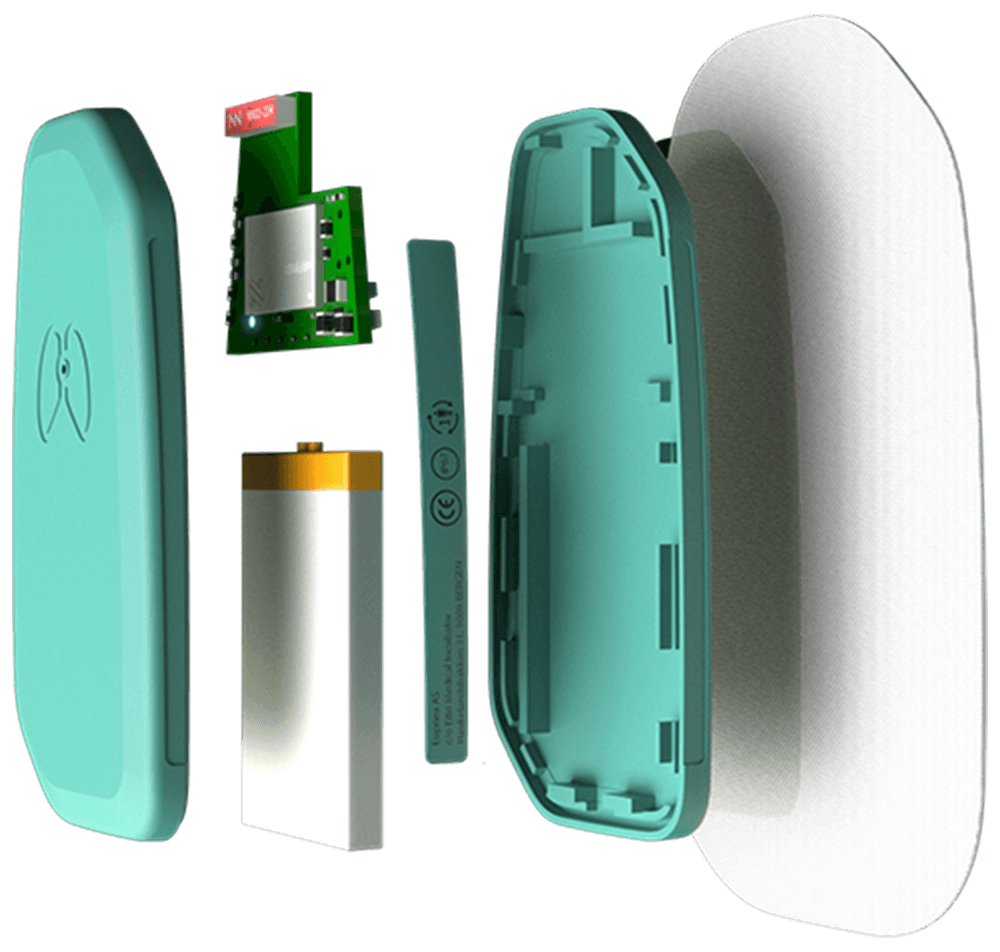Endringer i pustemønster og frekvens er det mest pålitelige forvarselet dersom pasientens helsetilstand forverres. Å gjenkjenne disse endringene gir et forsprang som kan hindre alvorlige hendelser, som hjertestans eller hasteinnlegging. Likevel registreres respirasjon fortsatt manuelt. På en travel vakt må andre gjøremål ofte prioriteres og manuelle målinger er omtrentlige og skjer for sjelden.
Slik overvåker Eupnea pust hos pasienter
Trådløst, individuelt og mobilt. Sikkert og i sanntid

Registrerer pustefrekvens og mønster

Sender data via 5G-nettet til analyse

Behagelig og enkel i bruk

Tilbakemelding i sanntid forbedrer pasientutfallet

Fokus på bærekraft i alle ledd

Maskinlæring og KI for økt klinisk innsikt og oppfølging

Behagelig og enkel i bruk

Sender data via 5G-nettet til analyse

Registrerer pustefrekvens og mønster

Tilbakemelding i sanntid forbedrer pasientutfallet

Fokus på bærekraft i alle ledd

Maskinlæring og KI for økt klinisk innsikt og oppfølging
Eupnea er utviklet av et norsk team med helsepersonell og innovatører innen sensorteknologi og datakommunikasjon. En liten trådløs sensor festes til pasienten og sender måledata over 5G til skyen, uten å gå via lokalt utstyr eller Bluetooth.

Eupnea er utviklet av et norsk team med helsepersonell og innovatører innen sensorteknologi og datakommunikasjon. En liten trådløs sensor festes til pasienten og sender måledata over 5G til skyen, uten å gå via lokalt utstyr eller Bluetooth.
Hvorfor?

Hvordan?
Eupneas trådløse sensor festes enkelt på brystet til pasienten. Sensoren er behagelig i bruk og man unngår kabler og batteriskift. Pusten måles kontinuerlig, pålitelig og driftssikkert, og måledata sendes kryptert og anonymisert til et norsk skybasert datasenter som drifter selve plattformen. Helsepersonell kan se måledata via plattformen og varsles ved kritiske endringer.
Hvor?

Pasienten
Sensoren følger pasienten og er utviklet for maksimal komfort og mobilitet. Plattformen sikrer og anonymiserer alle helsedata. Eupnea eliminerer manuelle feil og utelatelser. Og ikke minst; å oppdage endringer tidlig hos pasienten bidrar til optimal behandling og kan redde liv.

Sykepleieren
Når Eupnea overtar tidkrevende respiratorisk overvåking og registrering, vil helsepersonell kunne konsentrere seg om andre viktige oppgaver, og arbeidsbelastningen reduseres.

Sykehus
Haraldsplass Diakonale Sykehus har i dag digital overvåkning av alle andre vitale tegn bortsett fra pust, som fortsatt telles manuelt. Pust er den vitale parameteren som endrer seg raskest ved sykdomsutvikling, men den overvåkes i dag manuelt. Sensoren og systemet vil derfor erstatte en manuell oppgave for sykepleiere, frigjøre kapasitet og øke pasientsikkerheten på sykehuset.
Teamet
Eupnea er et selskap med spesielt fokus på respiratorisk overvåking. Med dedikert medisinsk og teknisk ekspertise, skaper vårt kjerneteam innovative løsninger for fremtidens helsevesen.


Øystein Theodor Ødegaard-Olsen
CEO / Prosjektleder

Jarle Heimtun
CTO

Kari Laupsa Helvik
Head of Growth - forretningsutvikler

Andreas Tunset
Chief Quality Officer (CQO)

Ib Jammer
Forskningsleder

Tørris Sjøset
Medisinsk ansvarlig

Dagrun Waag Linchausen
Styreleder
Partner
Eupnea samarbeider med ledende forskningsinstitusjoner, helsepersonell, tekniske utviklere og innovasjonspartnere for å sikre optimal kvalitet på våre produkter. Vi er åpne for flere fagmiljøer og investorer som deler vår visjon og vil forme fremtiden for smart respiratorisk overvåking.


Intelligent sensorteknologi
for sanntids respiratorisk overvåking
c/o Eitri Medical Incubator
Haukelandsbakken 31, 5009 BERGEN
Org: 918140964
Opphavsrett 2024



